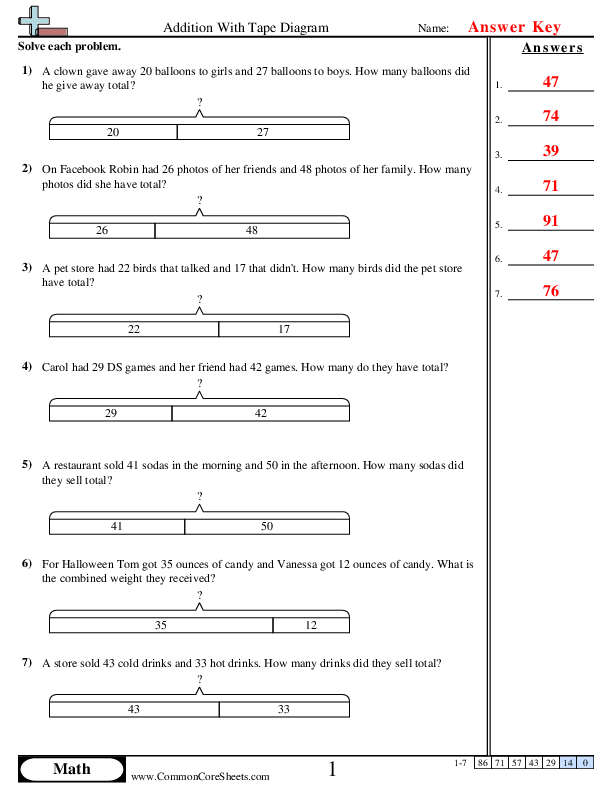
Looking for the best tape diagram worksheets on the internet? Look no further! Our free worksheets provide a clear and concise way to teach your students this valuable math skill. With these tape diagrams, your students will be able to visualize math problems and create models that help them solve them. Our worksheets are designed with simple, easy-to-follow diagrams that help your students understand how to solve equations with tape diagrams. Your students will quickly learn how to work with fractions and decimals through these visual aids. So don't wait - get the best tape diagram worksheets on the internet today - they're free!
Jump to a Heading > Filter By Grade > Browse Sheets By Problem Type List View (old) Image Size Smaller Larger Solving with Tape Diagrams Link
× Description:
"This worksheet is designed to improve children's addition skills using concrete examples and tape diagrams. With seven real-life scenarios in math, ranging from sodas sold at a restaurant to photos on Facebook, it offers engaging ways to practice numerical addition. It's versatility allows it to be customized, converted into flash cards, or utilized for distance learning, crafting an interactive learning experience for kids." × Student Goals:
Enhanced Mathematical Skills
After completing this worksheet, students should have honed their skills in basic addition. They will have had the chance to develop their ability to perform simple sums without the need for a calculator, encouraging mental agility and strengthening their grasp on foundational mathematical principles. This improvement in their numerical capability can be applied to more complicated mathematical problems moving forward.
Improved Problem-Solving Abilities
This worksheet should give students the opportunity to enhance their problem-solving skills. The problems presented require students to understand the situation, identify the numerical elements, and solve the given problems by applying their addition skills. By tackling these issues, students will grow their capacity to approach, evaluate and solve problems - a universally useful skill set.
Developed Logical Thinking
With this worksheet, students are encouraged to deepen their logical thinking abilities. This key skill will be fostered as they read through the problems, identify relevant information, determine the appropriate method of resolution (addition), and apply it accordingly. A strong foundation in logical thinking can extend beyond the math classroom, supplying students with the tools to make rational decisions and reason effectively.
Understanding of Real-World Applications
By performing these exercises, students will gain an appreciation of how fundamental mathematical concepts are applied in everyday situations. From calculating costs to measuring quantities, it translates abstract mathematical concepts into tangible, real-life examples. The practical relevance of the exercises will help students understand the importance of math in their daily lives, improving their motivation to learn.
Better Comprehension of Mathematical Language
These exercises should enhance students' understanding of mathematical language. They need to decode language-rich problem descriptions, deciphering and translating these word problems into numerical calculations. This skill effectively improves their math literacy and makes them ready to deal with more complex mathematical texts and problems in the future.
Lastly, successful completion of this worksheet will help boost students' self-confidence in their mathematical abilities. This self-confidence can prompt more enthusiastic participation in mathematics-related tasks, encourage a love for the subject, and reduce math-related anxiety.
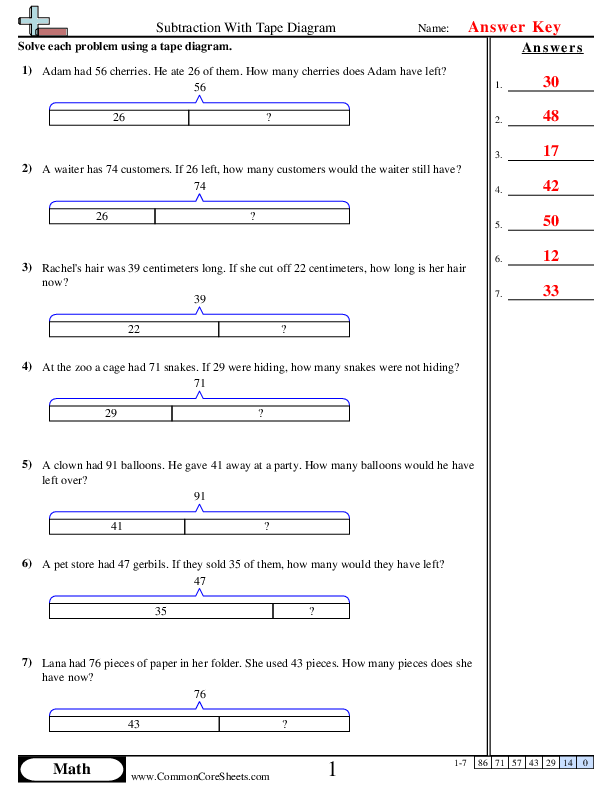
× Description:
"This worksheet is designed to improve kids' math skills, focusing on subtraction using tape diagrams. With its 7 practical problems, it helps children understand and apply the concept of subtraction in everyday situations. Suitable for distance learning, this highly customizable worksheet can also be converted into flash cards to enhance the learning experience." × Student Goals:
Subtraction Proficiency
Upon completing this worksheet, students should have developed a high level of comfort with subtraction. Mastery of subtraction techniques is crucial for advancing math skills, and practicing with real-world examples makes it easier to understand. This task demands critical thinking, as students not only subtract numbers but also apply this knowledge to practical situations, which helps enhance their overall numeracy skills.
Application of Math in Everyday Life
This worksheet imparts the ability to apply mathematical principles to everyday situations. Students will begin to view math as a handy tool for solving daily problems, which can raise their interest and involvement in the subject. They will be able to use subtraction to calculate differences in quantities in multiple contexts like counting money, quantities of items, number of people and more.
Problem Solving Skills
Successfully answering these problems requires a strategic approach to problem-solving. Students need to understand the problem before solving it accurately. This hones their problem-solving skills and enables them to approach challenges systematically, fostering the ability to think logically and strategically, which benefits them beyond just mathematical tasks.
The worksheet enhances reading comprehension as students need to read and understand problem statements before performing the required subtraction. Mastering this skill can have significant positive effects on their academic success in all subject areas, as most require reading and comprehension skills.
Fine-Tuning Motor Skills
Students reinforce their motor skills by writing or selecting the correct answers, which might involve the use of computers or tablets for digital worksheets. This exposure is integral in developing digital literacy and hand-eye coordination. Moreover, regular practice can also benefit the precision of their handwriting for physical worksheets.
Confidence And Independence
Finally, successfully completing this worksheet will build students' confidence in their mathematical abilities and encourage independent thinking. Successes in this can translate to a more positive attitude towards other challenging tasks, ultimately fostering a love for learning and intellectual curiosity.
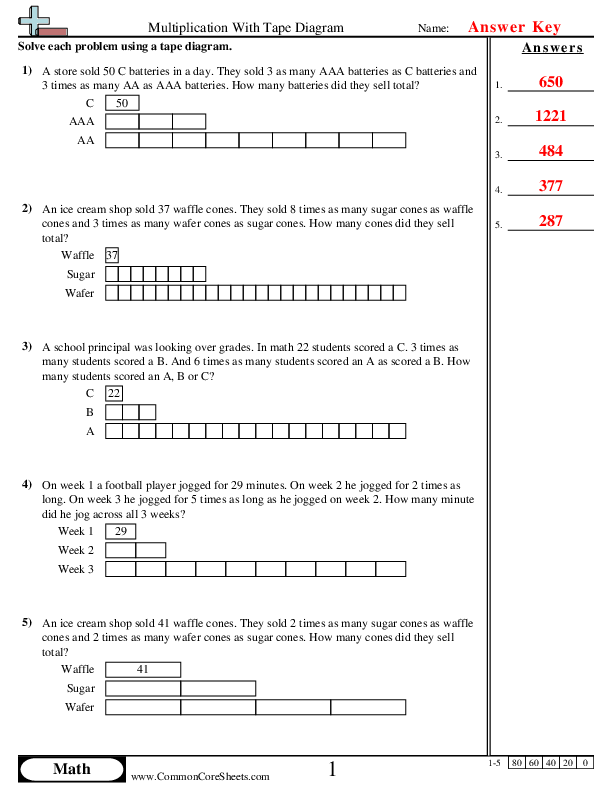
× Description:
"This worksheet is designed to help children master the concept of multiplication using tape diagrams. It features five engaging problems in practical scenarios involving grades, sale of batteries, restaurant utensils, and jogging durations. Customizable for unique learning needs, it's ideal for distance learning environments and its contents can easily be converted into flashcards for self-testing and review." × Student Goals:
Understand and Utilize Tape Diagrams
Upon completing the worksheet, students should have a firm grasp of multiplication with tape diagrams and utilising them as a visual tool to solve word problems which involve ratios and proportional reasoning. They should be able to analyze the tape diagrams, identify the relationship or ratio described, and use that information to derive an answer.
Enhance Multiplication Skills
The worksheet is geared towards improving the students' proficiency in multiplication, a vital aspect of arithmetic. By applying multiplication to differing contexts (such as scores, quantities, or time frames), students should be able to demonstrate improved multiplication aptitude and fluency in utilizing the operation to derive solutions.
Improve Word Problem Solving Abilities
Students should be better equipped to sort through the text of word problems, extract the necessary numerical data alongside the relations that link it, and turn it into a solvable equation. They should also be able to decode the question in the word problems, understand what is being asked, and suitably relate it back to the given data.
Develop Logical & Critical Thinking
The nature of word problems on the worksheet encourages the development of logical and critical thinking skills. Students need to identify patterns, comprehend ratios and their impact, and use logical reasoning to ascertain the steps needed to reach the desired outcome. As a result, completion of the worksheet should aid children in enhancing these vital cognitive abilities.
Apply Mathematical Concepts to Real-World Scenarios
On completing the worksheet, students should be able to discern the role of multiplication in real-life situations, as exemplified by the context of the word problems. They should be able to see the relevance of learning mathematical concepts, like multiplication and ratios, and their application to real scenarios, thus, instilling an appreciation for math.
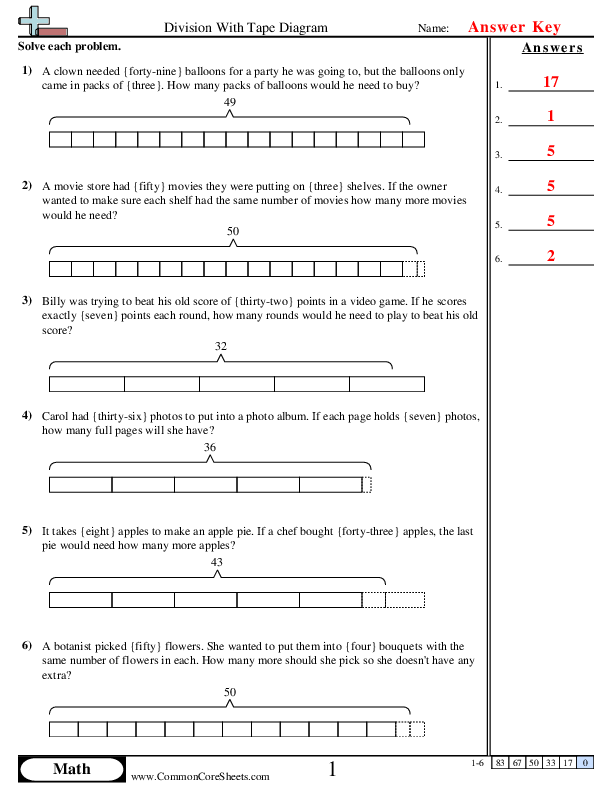
× Description:
"This worksheet is designed to enhance children's understanding of the division concept using everyday scenarios. Through 6 distinct math problems involving quantities and division, kids learn to solve practical problems with divided quantities. This customizable worksheet can be converted to flash cards for studying, and is suitable for distance learning, fostering kids' analytical and logical thinking skills." × Student Goals:
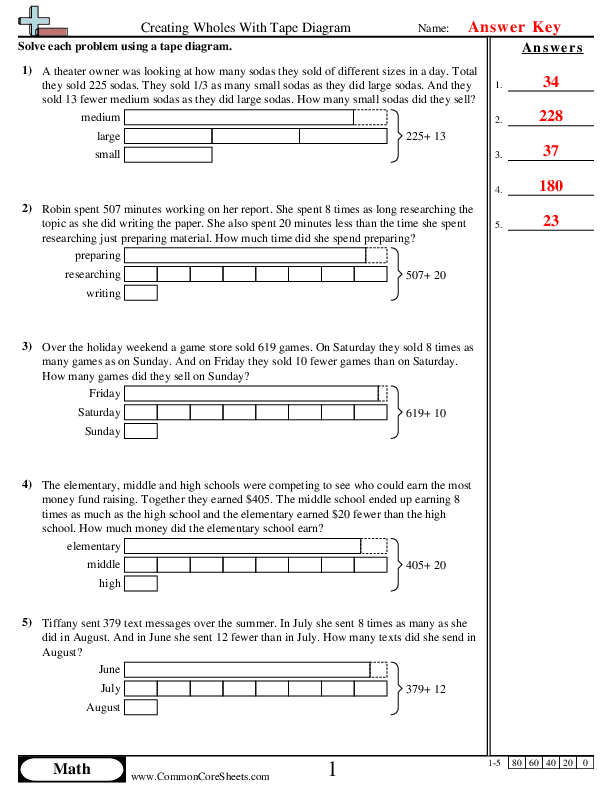
× Description:
"This worksheet is designed to teach children the concept of mathematical problem-solving using tape diagrams, focusing on relationships between whole quantities. Students tackle five dynamic problems involving real life scenarios ranging from fundraising, time management, business operations, baking, and communication patterns. The worksheet can be customized, converted into flashcards for reinforced learning, or used in distance learning environments, ensuring versatile and engaging experiences." × Student Goals:
Enhanced Problem-Solving Skills
After completing this worksheet, students should have a strengthened ability to tackle complex problems using logical thinking. They should be able to interpret real-life situations and convert them into mathematical equations, and vice versa. Thereby, they'll sharpen their problem-solving skills, a universal asset applicable in diverse academic and daily life situations.
Proficiency in Mathematical Calculations
Students should be able to calculate math problems effectively, using a variety of mathematical operations such as addition, multiplication, and division. These foundational calculate skills are essential and will act as building blocks for more complex mathematical problems in later studies.
Understanding of Proportional Relationships
After engaging in these exercises, students will gain an improved understanding of the concept of proportional relationships. Through numerical examples, they'll gain the capacity to determine and compare proportions, fostering their ability to envision larger number relationships and trends.
Improved Reading Comprehension
The practice provided by the worksheet helps enhance the students' reading comprehension skills. They must carefully read and understand the word problems to determine the steps needed to solve each problem. This skill is useful not only in higher-level math, but also across various academic subjects.
Development of Strategic Thinking
With the given problems, students will develop strategic thinking. They will learn how to effectively use strategies such as tape diagrams to visualize the elements of a problem, organize information, and understand the relationships between different components. This skill, once developed, is transferable across other subjects and real-life scenarios.
Enhanced Analytical Skills
Finally, students should be able to demonstrate improved analytical skills. They should be able to decide on the best methods for solving problems and justify their choices. They will be able to analyze the problem, apply the correct mathematical process, and draw valid conclusions based on their analyses. These are critical skills for future math work as well as a broad range of careers and life scenarios.
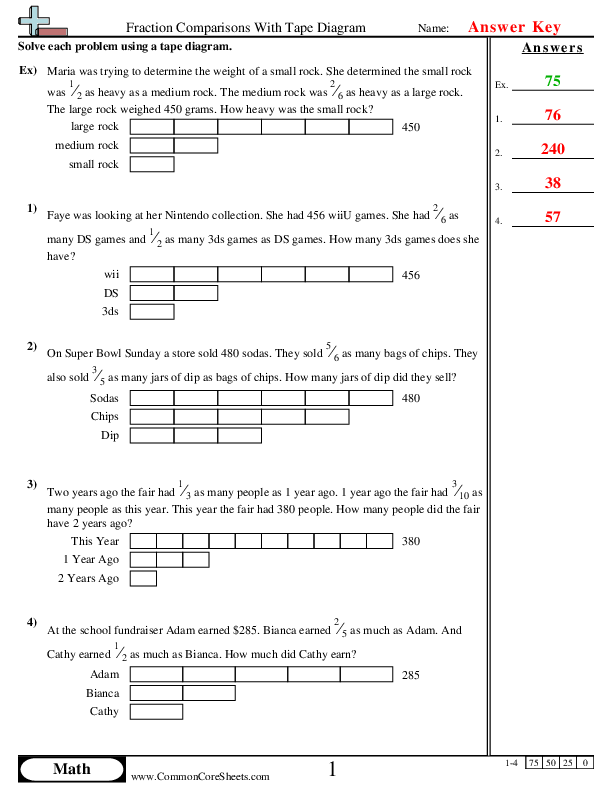
× Description:
"This worksheet is designed to aid learners in comparing fractions with tape diagrams through various real-life scenarios. The concepts introduced are pivotal to understanding math, with four diverse problems involving shopping, weights, game collections, fair attendees, and Super Bowl snacks. The worksheet can be customized to match any proficiency level, transformed into flashcards for better retention, and even used in distance learning settings, promoting seamless, effective learning." × Student Goals:
Understanding Fractions
Students will have gained a firm grasp on how fractions work, and how they can be applied to real-world scenarios. They will understand that fractions are a method of denoting partial quantities, and will be able to visualize them through the use of tape diagrams. This represents foundational knowledge for further studies in mathematics.
Comprehension and Application of Mathematical Concepts
They will be able to use fractions to accurately determine quantities. They should be capable of applying the principles of fractions to complex, multi-step problems. They will be able to compare quantities using fractions and leverage this ability to investigate ratio, proportion, and other advanced mathematical concepts.
Problem Solving and Logical Reasoning
Upon completion of the worksheet, students will have significantly developed their problem-solving skills. They will be able to take structured, logical steps to break down and solve the problems at hand. They will grasp the importance of order and sequence in mathematical equations.
Students will boost their critical thinking skills. They will learn how to analyze problems, identify the necessary calculations, and form conclusions based on their calculations. They will be able to understand and interpret the implications of their results.
After completing this worksheet, students will understand the relevance of math in the real world. They will see how fractions can be used to handle practical problems, such as those found in cooking, shopping, and scaling objects. This understanding will continue to motivate them to learn more advanced math concepts.
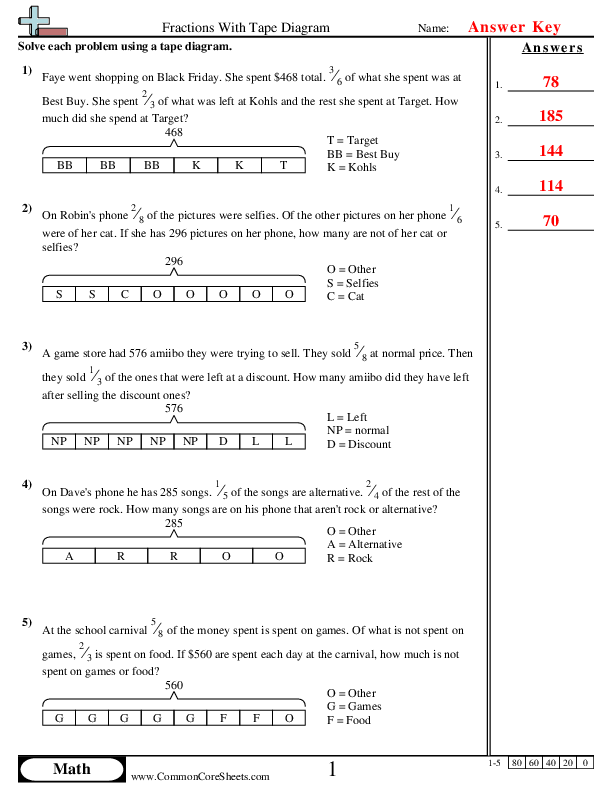
× Description:
"This worksheet is designed to enhance children's understanding of fractions using tape diagrams. Featuring five engaging scenarios across varied real-world contexts, the worksheet elevates math skills while teaching the application of fractions. It can easily be converted into flash cards, customized to fit individual learning paces, or used as a valuable resource for distance learning." × Student Goals:
Understanding Fractions
After completing this worksheet, students should have a thorough understanding of fractions and be better equipped to interpret and work with them in different contexts. They will comprehend how fractions are used to divide and distribute quantities and will be able to apply this knowledge to real-world situations.
Problem Solving Skills
This worksheet will enhance students' ability to solve problems with multiple steps. They will be able to segment large problems into manageable parts, approach each part systematically and then piece together these parts to come up with a complete solution.
Application of Math to Everyday Situations
The examples given in the worksheet anchors the concept of fractions to relatable everyday scenarios like shopping, playing games, organizing photos, or managing inventory at a store. By completing this, students grow comfortable in applying mathematical concepts to grasp, analyze, and navigate situations they encounter daily.
Sequencing and Patterning
Through the diagram representations provided, students will learn how to use sequencing and patterning to predict results, a skill that is fundamental to both mathematical calculations and logical reasoning. By understanding the link between fractions and how they are arranged or follow a pattern on a number line or diagram, students can develop a physical intuition about fractions.
Enhancement of Computational Skills
In completing the worksheet, students will be repeatedly required to execute basic arithmetic operations such as division, multiplication, addition, and subtraction, thereby reinforcing their computational skills. This recurring practice allows students to become faster and more accurate in their calculations.
Conceptualizing Real-life Scenarios into Mathematical Problems
Upon completion of the worksheet, students will be adept at interpreting and abstractly representing real-world scenarios as mathematical problems. They will become skillful at deciphering and converting word problems into mathematical equations, an ability integral to mathematical proficiency.
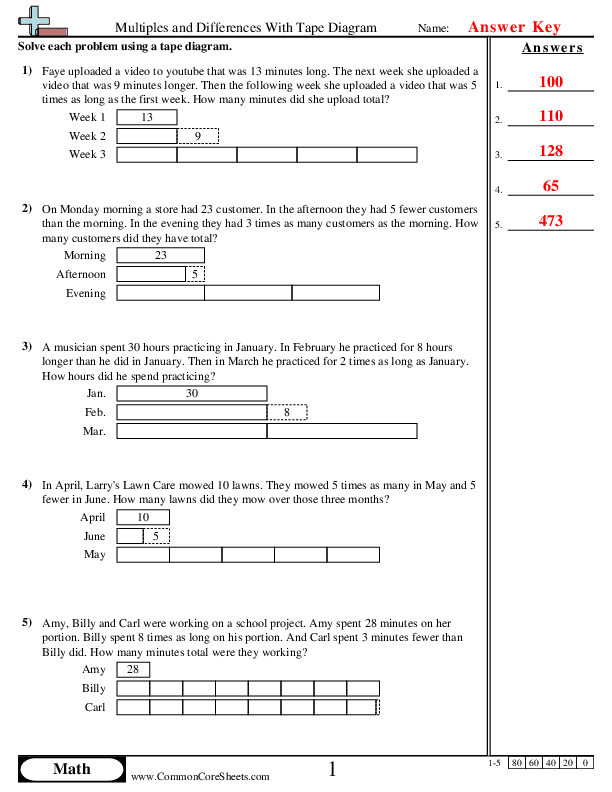
× Description:
"This worksheet is designed to sharpen kids' math skills. The 'Multiples and Differences With Tape Diagram' worksheet features 5 problems covering various everyday scenarios. Students apply multiplication, subtraction, and addition to solve problems, enhancing their conceptual understanding. This versatile tool can be customized, transformed into flashcards, or integrated into a distance learning curriculum, making math more engaging and interactive." × Student Goals:
Improved Mathematical Understanding
After completing the worksheet, students should have improved their understanding of mathematical concepts such as multiples and differences. By tackling problems involving situations in various scenarios, children are expected to grasp how basic operations translate into everyday situations.
Enhancing Problem-Solving Skills
Children are expected to develop better problem-solving skills. The worksheet provides complex problems that require the students to carefully read through, comprehend, and solve. These exercises promote critical thinking and encourage students to come up with strategic solutions to mathematical problems.
Adoption of Real-World Math Applications
The worksheet helps students recognize how mathematics applies to real-world scenarios. By integrating mathematical problems to context such as fundraising activities, efforts in a restaurant, or page-reading habits, students gain an awareness of how mathematics interlinks with their day-to-day experiences.
Multiplication and Subtraction Proficiency
Students will advance their skills in multiplication and subtraction. The problems in the worksheet require them to determine multiples of given numbers and also compute differences, hence enhancing their arithmetic proficiency.
Boosted Numeracy Confidence
The ability to successfully complete the worksheet will boost the students' confidence in their numeracy skills. They'll gain self-assurance in their ability to tackle mathematical problems, which is a vital aspect of their academic growth and progress.
Enhanced Logical Thinking
Children completing the worksheet are anticipated to improve their logical thinking skills. The exercises require students to follow sequences, discern patterns, and apply logical reasoning to resolve mathematical problems. This greatly improves their analytical thinking capability.
Enriched Communication Skills
While maths is primarily about numbers, skills in reading and understanding problem statements are equally crucial. Through the comprehension of these word problems and their translation into mathematical equations, students will enhance their communication skills in the subject.
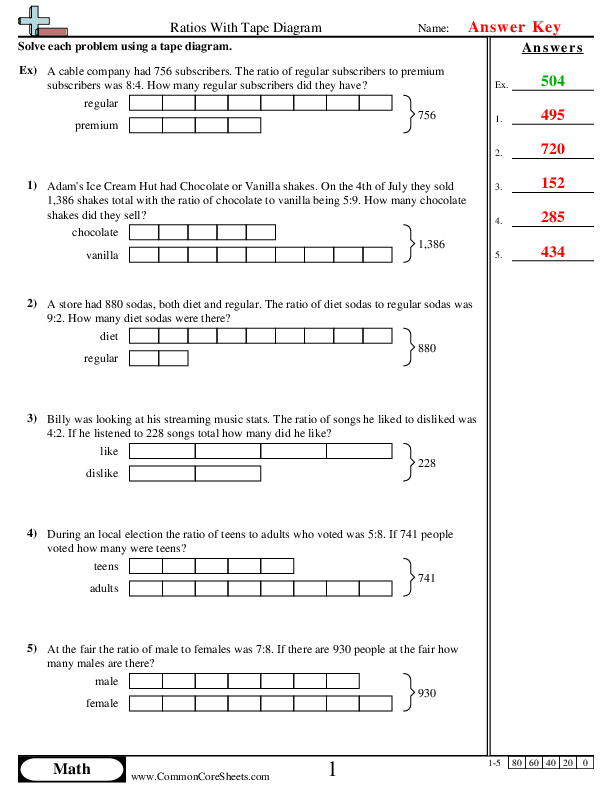
× Description:
"This worksheet is designed to help children grasp the concept of ratios using tape diagrams in the context of real-life scenarios. With five problems from diverse spheres, such as store inventory, music streaming, elections, and more, students learn to apply ratio knowledge effectively. Tailored for customization, this versatile tool can also be converted into flashcards or integrated into distance learning platforms—engaging, versatile, and paramount for foundational mathematical skill development." × Student Goals:
Understanding Ratios
Students will further develop their understanding of ratios and how they apply to real-life scenarios. They will comprehend the concept that ratios represent a relationship between two quantities. While working through the problems, they will familiarize themselves with the vocabulary used to describe ratios, such as 'to' or ':'. This deeper understanding of ratios will not only enhance their mathematical competence but will also serve as a foundational skill in many everyday life problems or situations involving comparisons, proportions, or predictions.
Students will enhance their mathematical problem-solving skills by applying logical and critical thinking to solve ratio problems. They should be able to identify the necessary information, formulate the problem effectively, carry out the computations, and verify their answers. They will learn how to translate a word problem into a numerical form and enact operations correctly. By the end of this worksheet, students will have developed a strategy for efficiently solving similar problems in the future.
Application of Ratios to Practical Scenarios
From ice cream shakes to a local election, this worksheet teaches students how ratios apply to a variety of real-life situations. They will be able to identify when and where ratios are applicable, understand the context, and appropriately apply their knowledge of ratios. This skill will enable them to make educated decisions based on their understanding of proportions in various practical situations.
Developing Computational Fluency
Students will boost their numerical calculation abilities by performing operations required to solve ratio problems. By repeatedly practising these skills, they will become more fluent and confident in their mathematical thinking and computational skills. These enhanced numerical abilities are essential not just in mathematics but across various subjects and in daily life.
Improvement of Reasoning Skills
Working out these problems will lead students to use and improve their mathematical reasoning skills. They should be able to explain why their solution is accurate in relation to the original problem, thereby demonstrating an understanding of ratio relationships and their implications. This development of reasoning skills is a critical aspect of mathematical learning, and promotes sophisticated thought processes and decision-making abilities in daily life scenarios.